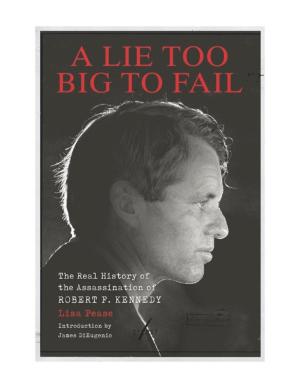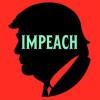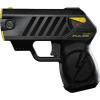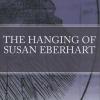The Real Story of the Assassination of Robert F. Kennedy
Editor’s Note: Donald E. Wilkes Jr. died suddenly Friday, June 7, 2019, of a suspected heart attack while on vacation with his family in Olympia, WA. As he had intended, he finished this review just before leaving town but called later and left a message, pointing out a typographical error he had previously overlooked in the text. He was being scrupulous, as usual, about every detail of the piece. See Pub Notes for Pete McCommons’ remembrance of Prof. Wilkes.
“It’s hard to overstate the significance of finding a current or future CIA contract agent holding [Robert F.] Kennedy’s right arm at the moment of the [RFK] shooting.”—Lisa Pease
After 25 years of extensive investigation, researcher Lisa Pease has written the eye-opening definitive work on the assassination of Robert F. Kennedy, whose shocking murder James DiEugenio rightly calls “perhaps the most ignored American historical milestone in the second half of the 20th Century.”

RFK, the 42-year-old younger brother of assassinated President John F. Kennedy, served as U.S. Attorney General from 1961–1964 and was elected to the U.S. Senate to represent the state of New York in 1964. At the time of his assassination, Sen. Kennedy had just won the 1968 Democratic presidential primary election in California and was widely regarded as the candidate most likely to be America’s next president.
Until very recently, the two best books on the RFK assassination were William W. Turner and John G. Christian’s The Assassination of Robert F. Kennedy: A Searching Look at the Conspiracy and Cover-Up 1968–1978, published in 1978, and Philip H. Melanson’s The Robert F. Kennedy Assassination: New Revelations on the Conspiracy and Cover-Up, 1968–1991, published in 1991. The authors were reliable researchers committed to the truth. Turner was an ex-FBI agent, and Christian a former broadcast reporter. Melanson was a political science professor at Southeastern Massachusetts University and director of the Robert F. Kennedy Assassination Archives there.
Both books, based on the evidence, forcefully maintained, among other things, that the assassination resulted from a conspiracy and that the police investigation was a cover-up—which included mishandling of witnesses, failures to investigate persons of interest and to pursue leads, and suspicious destruction of physical evidence.
Lisa Pease’s superlative A Lie Too Big to Fail (Feral House, 2018) builds on but largely supersedes these two books. In the words of respected assassination researcher James DiEugenio, who wrote the introduction, Pease’s 512-page book “makes a quantum leap forward, in both the explication of the crime and the cover-up.” The book is based on archival documentation, witness interviews and, most importantly, newly discovered evidence found by Pease.
The key factual allegations in the book—many of them astounding—are backed up in the 848 footnotes that invariably confirm the accuracy of Pease’s assertions.
Overview of the RFK Assassination
RFK’s assassination took place shortly after midnight on Wednesday, June 5, 1968, as RFK walked through a crowded food preparation area (better known as the kitchen pantry) in the Ambassador Hotel on Wilshire Boulevard in Los Angeles, CA. This hotel was closed in 1989 and torn down in 2005. Six public schools, named the Robert F. Kennedy Community Schools, now stand on the site.
The alleged assassin, Sirhan B. Sirhan, a 24-year-old Palestine-born non-Muslim with Jordanian citizenship, was one of approximately 77 persons in the pantry waiting for RFK to pass through on his way to a press conference. When the senator entered, Sirhan pulled out an eight-shot .22 caliber revolver, pointed it at the senator and fired eight times. Sirhan was immediately seized by bystanders, wrestled to the floor and turned over to police when they arrived.
Six persons in the pantry received bullet wounds. Three bullets struck RFK. One bullet lodged in his spine near the neck; another bullet exited his chest; a third bullet, the fatal one, entered his head. A fourth bullet passed harmlessly through his clothing. The five other victims were shot non-fatally.
Sirhan’s California state court trial for the murder of RFK began on Feb. 13, 1969, and ended two months later on Apr. 17, when the jury found Sirhan guilty. The trial judge imposed a death sentence, reduced to life imprisonment by the California Supreme Court in 1972. Incarcerated now for 51 years, Sirhan is still serving that sentence.
The official government version of the RFK assassination—the stated view of the FBI, the Los Angeles Police Department and prosecutors in the Los Angeles District Attorney’s office—is that Sirhan was the lone assassin, that Sirhan fired all the shots in the pantry and that there was no conspiracy. According to the official narrative of the assassination, therefore, a single assassin acting alone slew RFK.
However, for persons who have scrutinized the facts surrounding the RFK assassination, or examined the quality of the official investigation, the official account lacks credibility.
Today, it is evident that there are glaring weaknesses in the official account—particularly its no-conspiracy contention. Major discrepancies exist between the official account and the actual evidence. The official probe of the murder was substandard and amounted to a cover-up. There is ballistics and autopsy evidence establishing the existence of a conspiracy.
The Ballistics Evidence of Conspiracy
The ballistics evidence by itself proves conspiracy. Since Sirhan’s pistol, when fully loaded, held eight cartridges, evidence that more than eight shots were fired in the pantry conclusively proves there was more than one shooter—and hence conspiracy. (Sirhan had no opportunity to reload his weapon.)
There is proof beyond a reasonable doubt that more than eight shots were fired.
Police recovered seven bullets from the bodies of the six victims and concluded that an eighth bullet, which was not recovered, was lost in the ceiling interspace. Yet there were at least two bullet holes in the pantry’s doorways, as well as, according to police, an “unbelievable number” of bullet holes in the ceiling panels. At least 10 bullets—and almost certainly several more—were fired.
The evidence of conspiracy from the number of bullet holes is not new, but Pease reexamined police and FBI photos of the doorways pierced by bullets. She also located previously unknown motion picture film of the crime scene. Based on this, she convincingly argues “that at a bare minimum 12 bullets had to have been fired in the pantry.”
There was, in short, overwhelming evidence that more than eight shots were fired. There had to be more than one shooter.
Sirhan’s attorneys, at his trial, ignored the bullet-holes issue. Seeking only to avoid the death penalty for a client they believed guilty, they stipulated throughout the trial to the admission of the prosecution’s often-questionable physical evidence.
Suspiciously, after Sirhan’s trial but before his appeal, the LAPD secretly destroyed the doorways and ceiling panels.
The Autopsy Evidence of Conspiracy
Like the ballistics evidence, the autopsy evidence, standing alone, demonstrates conspiracy.
Unlike his assassinated brother, RFK received a first-class autopsy whose results are trustworthy. Renowned medical examiner Thomas Noguchi performed the autopsy. The autopsy report and Noguchi’s trial testimony reveal that (1) all three bullets striking RFK were fired from behind him, and (2) the three bullets had been fired at point-blank range—“[the] muzzle distance… was very, very close.” The fatal bullet was fired from a firearm “one inch from the edge of [RFK’s] right ear and three inches behind the head.”
Sirhan could not possibly have fired these three shots. He was in front of RFK and never came within 4 or 5 feet of him.
The evidence of conspiracy based on the autopsy is not new, but Pease restates that evidence to make it more comprehensible to the average person.
Pursuant to their strategy of not disputing his guilt, Sirhan’s trial lawyers disregarded the autopsy evidence that demonstrated their client could not have fired the bullets that hit RFK.
The Police Cover-up and the CIA
The LAPD investigation of RFK’s murder was strangely botched and amounted to a cover-up.
Suspicious circumstances were ignored. Investigatory leads were not pursued. A dozen or more unknown persons in the Ambassador Hotel who had acted suspiciously were never identified. Witnesses with no reason to lie who gave plausible statements suggesting the presence of conspirators in the pantry were treated coldly and urged to change their story. Questionable statements given by persons with reason to lie were accepted at face value. Written witness interview statements were altered. Over 3,400 witness interview tape recordings were destroyed. Written transcripts of undestroyed witness interview tapes did not correspond to what was on the tapes. Police evidence logs were falsified. Crime lab experts tampered with evidence, faked test results and testified falsely. Over 2,400 photos were incinerated. Physical evidence (including the doorways and ceiling panels) also was destroyed. The crime lab could not match any of the recovered bullets with Sirhan’s pistol.
In the 1950s and ’60s, Melanson’s book revealed four decades ago, the CIA “had a clandestine relationship with numerous [police] departments. The Agency provided largess for officers, training and gratis equipment (often of an exotic nature). Police returned the favor by conducting surveillance and break-ins for the Agency and providing police credentials to CIA operatives. Documents [obtained under the Freedom of Information Act] specifically mention Los Angeles as one of the cities that received ‘training.’”
Unsurprisingly, researchers have suspected the CIA was involved in—perhaps even orchestrated—the LAPD cover-up. Pease’s book confirms these suspicions. She proves, for example, that LAPD Lt. Manuel S. Pena, who was the head of the special police unit responsible for investigating RFK’s assassination, was a CIA operative or asset.
Robert Maheu, Howard Hughes and the CIA
Pease believes RFK’s assassination was the result of a conspiracy organized by Robert Maheu and the CIA and that the actual murder was carried out by a secret team of undercover operatives as part of a covert operation arranged by Maheu.
Maheu was a wealthy lawyer and clandestine espionage activities specialist who owned private security firms and was, Pease writes, “extremely well-connected at the highest realms of power in the country.” He was an ex-FBI agent and an ex-CIA employee with ties to the highest and most secretive levels of the CIA. After he left the CIA, he continued to perform “cut-out” CIA assignments, meaning he would carry out sordid or illegal tasks for the CIA to which it could not be officially linked. Maheu used one of his companies to front for CIA activities and provide cover for CIA agents. The “Mission Impossible” TV program is believed to be based on that Maheu company.
Maheu had close connections with organized crime leaders. When the CIA leadership infamously decided to recruit the Mafia to murder Fidel Castro, they turned to Maheu to introduce them to Johnny Roselli and other gangland leaders.
From around 1955–1970, Robert Maheu worked for the Hughes Organization, the business empire of legendary reclusive multi-millionaire Howard Hughes. At that time, the Hughes Organization, we now know, was loaded with CIA people and had practically been taken over by the CIA. Maheu was a top assistant to and close confidant of Hughes.
The mysterious Hughes had such close ties to the CIA that James Angleton, the infamous, unscrupulous chief of the CIA’s counterintelligence section for 21 years, spoke in praise of Hughes at Hughes’ funeral.
In the 1950s and ’60s, therefore, the CIA, Hughes and the Hughes Organization, and Maheu and his private security firms were all inextricably (but surreptitiously) linked.
Thane Eugene Cesar
Pease’s book provides amazing new information on a man named Thane Eugene Cesar, long a curious figure in the RFK assassination case.
When he entered the pantry and the gunfire began, RFK’s right arm was being held, supposedly to guide him, by armed uniformed security guard Cesar, who was to the right of and close behind the senator. The 26-year-old Cesar worked for Ace Guard Service, a private security firm hired by the hotel. At the time of the assassination, Cesar had previously worked for Ace Guard Service for only one day, during the previous week. Under the government narrative, Cesar was the only person (except the assassin) in the pantry with a gun.
As RFK collapsed, he somehow grabbed and pulled off Cesar’s clip-on tie, which ended up on the floor. In the uncropped iconic black-and-white news photo depicting RFK flat on his back on the pantry floor being comforted by busboy Juan Romero, Cesar’s tie may be seen lying on the floor about two feet from the dying man’s outstretched right arm. (Romero died of a heart attack in October 2018 at age 68.)
When the shooting began, according to his own statement and those of several witnesses, Cesar drew his handgun. He told police he never fired it, although at least one witness said Cesar fired it once. Suspiciously, police did not examine Cesar’s pistol. Cesar later admitted to police that he owned or previously owned a .22 pistol, but claimed he was carrying a different weapon—a .38 revolver—the night RFK was shot. Interviewed by police multiple times, Cesar’s account of events in the pantry kept changing.
Despite orders to keep unauthorized persons out of the pantry, Cesar failed to do so, with the result that Sirhan and other unauthorized persons moved freely in and out of the pantry. Cesar took it upon himself to give RFK a safe escort through the pantry, and failed. He drew his sidearm—and may have fired it—in a room full of people.
“The kindest thing we can say about Cesar,” Pease writes, “is that he failed utterly in his job.” Pease adds: “He was in the perfect position to have been the gunman who killed Kennedy or to have held Kennedy, shielding other shooters from view as they fired upon Kennedy from nearly contact range… [I]ndeed, it’s difficult not to imagine Thane Cesar not being involved.”
There is a photograph of Cesar in the Turner and Christian book. It was taken shortly after RFK was shot, and shows Cesar with his clip-on tie missing.
In the 1960s and ’70s, Cesar worked at a Lockheed Aviation plant in California. A casual acquaintance who also worked there told researchers Turner and Christian that the plant was a CIA-controlled U-2 spy plane facility, and that Cesar often worked in an on-limits area that only special personnel had access to.
On top of all this, Cesar was a right-wing extremist who hated the Kennedys and supported racist Alabama governor George Wallace.
Is it surprising that, for years, assassination researchers have considered Cesar a possible conspirator in a covert operation to assassinate RFK? Or that Cesar has been suspected of being part of a CIA assassination team?
Ever the diligent investigator, Pease has uncovered startling new information about Cesar’s background, connecting him to the CIA or its assets. It includes this:
-
Sometime in the mid-1970s, Cesar told the LAPD that he worked at Hughes Aircraft—which was a subsidiary of the Hughes Organization.
-
Cesar was once spotted in Las Vegas in the company of a Florida hitman. The person who saw him remarked, “He is owned by Howard Hughes, and his name is Thane Cesar, and he is as tough as they come.”
-
John Meier, a top aide to Hughes from 1966–1970, knew Cesar, because Cesar worked for the Hughes Organization. Shortly after the RFK assassination, while listening to a radio broadcast about the assassination, Meier heard Cesar’s name mentioned as one of the security guards at the Ambassador Hotel. In his personal diary entry for June 13, 1968, Meier wrote: “I remember Thane from his trips to Las Vegas where he was meeting with numerous gaming people and was introduced to me by Jack Hooper, an associate of Bob Maheu.” A top aide to Howard Hughes knew Thane Cesar.
-
In an interview with Lisa Pease, John Meier told her that after hearing the radio broadcast, he “called someone and discussed the fact that I knew… Thane Cesar… who had been at the Ambassador that night.” The next day, Meier was summoned by Maheu and chewed out. “[Maheu] was furious and wanted to know why I was checking up on Thane. I was stunned at his anger, and he said to me that if I kept discussing this matter, he would see that I was no longer around the Hughes operation.” Robert Maheu and Thane Cesar knew each other, and Maheu did not want outsiders to know it.
-
The next day, Meier informed Pease, Jack Hooper told Meier “that he was speaking with Bob Maheu, and I was never to mention [Thane Cesar’s] name or Bel Air Patrol.”
-
Bel Air Patrol was a California private security guard service, owned by Maheu, where Cesar worked prior to the assassination. Thane Cesar worked for Robert Maheu.
-
Perhaps most importantly of all, Pease subscribed to two prominent online “public records database aggregation” services, both of which reported to her that Cesar’s profession was “contract agent” for the CIA. Thane Cesar was a CIA man.
The Second Dallas
There is an excellent 2011 documentary about the RFK assassination on YouTube. Titled “The Second Dallas,” it focuses on flaws in the official government account of the assassination, including but not limited to the ballistics evidence proving that more than eight bullets were fired, the autopsy evidence proving that RFK was shot at close range from behind, and the bizarre police behavior in destroying the doorways and ceiling panels. The documentary concludes that most likely Cesar was the assassin.
The point of the documentary’s title is to drive home the contention that, as was the case with respect to President John F. Kennedy’s assassination in Dallas, TX, the assassination of Robert F. Kennedy (1) resulted from a conspiracy, (2) was followed by an inadequate investigation that was basically a cover-up and (3) occasioned a doubtful official account of the assassination, placing the blame on a single person acting alone.
Pease’s A Lie Too Big to Fail demonstrates that the documentary was correct. The RFK assassination was indeed a second Dallas.
But Pease’s explosive book does far, far more. Currently, and for many years, the CIA—quite justifiably—has been the chief suspect in the JFK assassination. Pease’s stellar, spectacular achievement is that, due to her splendid research and staggering discoveries, the CIA—quite justifiably—now must be considered the chief suspect in the RFK assassination.
Addendum: Space limitations prevent discussion here of why the CIA would have wanted JFK and RFK killed, and whether it had the resources to carry out their assassinations and cover up its involvement. It will suffice to note that today there is ample proof that (1) many CIA people, high and low, and particularly the ones involved in CIA assassination plots and illegal covert operations, hated and despised the Kennedy brothers, almost to the point of insanity, and (2) in the 1950s and ’60s, the CIA was deeply committed to murdering people without being detected, and, in the words of the late Mark Lane, “functioned as an international murder incorporated.”
Donald E. Wilkes, Jr. was a Professor of Law Emeritus at the University of Georgia School of Law, where he taught for 40 years. He published nearly 120 articles in Flagpole.












comments